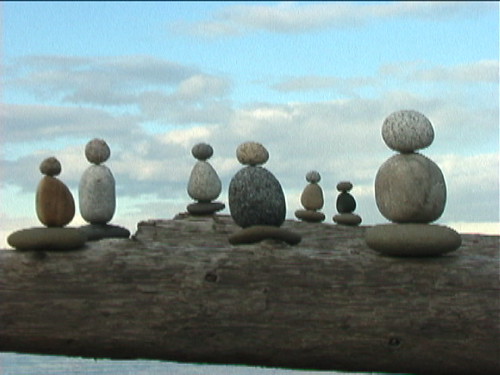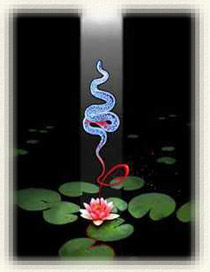~Macrina Wiederkehr
I have felt lately as if I'm walking on the bottom of the river, and all the words and images are on the surface, in the light, where I can see them but not quite reach them right now. As I begin to describe what I'm seeing, I imagine they will seem to be separate fragments, and numerous, floating there on the surface -- but from down here they I know that they all send down filaments that criss-cross every which way, in time and space and meaning, way below the surface, and that's why this is such a long blog post instead of several separate ones.
((.)) This morning I spent a brief time holding the hand of a colleague and friend who last week was diagnosed with Creutzfeld-Jakob disease. Six weeks ago she was still her radiant self: seeing clients, and writing, and immersed in her wide circle of friends and spiritual community, with no trace or hint of disease. From the outside she looks like she is sleeping. On the inside, I know that her brain has filled with little holes, like a sponge. On the deeper inside, I know that in a day or few, perhaps by the Solstice, she will have completely dissolved back into her radiant Self.
A message just came from the website her family and friends have been keeping, to tell her many circles that our friend "...left us just as the Solstice came to be this mid-morning of June 21, 2007. She is free now to move to another plane, her abiding spirit able to move to even greater heights. She had a smile on her face as she departed."
The last time we had coffee together was a few months ago, and we talked a lot about our mutual friend Bill, who died abruptly in January.
((,)) Last month, I phoned a friend to see if I could join him for a "bird-sit" the next morning, a pre-dawn meditation in the woods that he and some other friends had been doing -- being present and listening as the birds wake up in the morning. It turned out that he was in New York, called back because his twin brother had had some trouble breathing, been diagnosed with advanced lung cancer, and then had a stroke while in the hospital. My friend's brother died less than a week later. They had just turned 41 in February.
((*)) In March, a cheer-ful and energetic woman whom I got to know while we were in Israel in 2004, was diagnosed with cancer in the gallbladder and liver, after having had many months of stomach pain, and after having lived through breast cancer 9 years ago. After extensive surgery, she was set to undergo follow-up radiation treatment when a routine CT showed that the cancer had already come back and grown more tumors in her abdomen. She manages to be devastated, deeply accepting of whatever comes next, and entirely open to miracles, all at once. She was at services two Shabbats ago, and looked great; you couldn't tell what was going on inside (the surface of the inside) if you didn't already know.
The stories aren't connected, except that each one is so intense, and abrupt, so peculiar, and life-threatening, or life-ending.
((')) Jack Ricchiuto writes in his beautiful new book, Conscious Becoming (which he wrote after an abrupt near-death experience of his own) (and which you can give as a wonderful gift to yourself or someone else, just by requesting the pdf version from Jack) : "When we are conscious, we love all the stories."
((-)) Almost a month ago was the holiday of Shavuot: the commemoration of revelation, of the people receiving the ten commandments (it turns out that a better translation would be the "ten utterances" or the "ten principles") at Mt. Sinai.
My sense of revelation right now: a moment fished out from the stream of light, a stream that could be -- and sometimes is -- a continuous dialogue, which lasts only as long as I am really listening.
Our rabbinic intern, Olivier, offered a traditional Shavuot night study session (well, we didn't stay up till the birds started singing, so it was not entirely traditional!) We talked a lot about the reverberation, the dance, between Descent and Ascent, the Yin and the Yang of creation and awakening. In the story of Sinai, the people (who are the Eternal in manifest, multivarious form) go up the mountain to meet the Mystery; the unmanifest Eternal comes down the mountain to meet the seekers/finders. Olivier says, "The universe wants this to happen, and it steps forth: God comes down" and we (all of us aspects of God), we go up. "But there is only so high we can go, while we live in bodies -- God has to come down." In our tradition, we also come back down, we don't stay on the mountaintop. For as long as we live in human form, we come down and go up and come down.
((~)) (I used these quotes from Jack and from Olivier in the "d'var Torah" (which means "Torah talk" and/or "Torah thing") that I gave recently at a Shabbat service celebrating the energies of the Divine Feminine. I've posted it at Ashley's generous forum, On the Wings of Curiosity.
Much later in the study session, we each drew a number from 1 to 10, our "utterance" to contemplate till next Shavuot. I picked number 3, which is the one that's translated "you shall not take the name of God in vain."
Olivier shared Rabbi Ted's teaching on this:
(It would be so much more charming and surprising and potent if you could hear Ted or Olivier tell it. In the meantime, you will have to settle for this paraphrase which is mixed with my own responses:)
It is only on the surface level that we would perceive that this should mean something as small as, "don't say 'God' as a swear word or curse."
Under the surface, on the inside, we remember the Self-name of God, the name that rumbles from the blazing bush in response to Moses' wondering who was speaking to him: Ehyeh asher Ehyeh ~~ I AM as I AM
If the name of God is I AM,
then who am I?
How can I take good care of this name?
In what ways do I use the name I AM unconsciously and what consequences does that generate? How often do I channel it into narrow pathways by the thought-less identifications I choose? Can I imagine I AM without bounds, without separation, without any identification at all?
((,)) I am filled with wonder and tears to read Chris' post, and all the keen and tender comments, on "Going to War at the Art of Hosting on the Art of Hosting" -- about clarity and surrender and collective shadow, about "fierce commitment to defend the territory of the open heart" and "the responsibility of love...never to push our adversary or interlocutor into a place they cannot go unless we are prepared and awake enough to go with them to guard their back."
((')) In a workshop over Mother's Day weekend, 5-element practitioner and Sufi healer Thea Elijah guided a classroom full of people in a practice of opening the heart and mind and body to whatever-it-is we conceive of as source (I am): First, let yourself trust the world to hold you, trust whatever- it- is you're sitting or standing or lying on to hold you up. It can help to widen your base (what Thea called "pyramid butt"). At the same time open the throat to awe and wonder (around the throat are many of the acupuncture points called the Window of the Sky points) -- that place in the throat that gets tight when we are very moved -- and open your mind and the crown of the head up to the Mystery and the "I don't know." Connected all the way Down, and all the way Up. With so much space going down and up, the heart space, the center of the body, can expand more easily. First, at the level of personal heart, at the front of the chest, where emotions are felt. Then let yourself go back, into the deep chambers of the heart, to the back of the body, the spine, which is our pillar of eternity, our connection to the Infinite. Then allow yourself to open past that, falling past eternity, and with the back body ("we are prepared and awake enough to go with them to guard their back") open, let yourself fill up from that source, which we can call by so many names ~ allah ~ elohim ~ deep love ~ I am ~ until you overflow into the group heart, the collective being.
 ((!)) During a summery, flowery, lunch on her deck, Anne asked me to describe that practice to her again. When I'd finished, she said that it reminds her of a sensation she often thinks of: when you are rafting down a river, with your feet pressed firmly at the front of the raft, and your arms lifted, chest open, feeling the current of the river through your back, holding you up, and carrying you on.
((!)) During a summery, flowery, lunch on her deck, Anne asked me to describe that practice to her again. When I'd finished, she said that it reminds her of a sensation she often thinks of: when you are rafting down a river, with your feet pressed firmly at the front of the raft, and your arms lifted, chest open, feeling the current of the river through your back, holding you up, and carrying you on.(cup of Anne's blooming heart tea)
((*)) On Saturday we attended the bar mitzvah of a friend's son, who in her apt words is "growing up beautiful and strong," including having healed from a brain injury from being kicked in the head last year by a group of kids who thought he shouldn't be in their neighborhood. He was magnificent, charming, genuine, funny (as my friend also said about her shining son in her little speech, "stylistically, there isn't anything more Jewish than the combination of intensity and humor").
Included in his service booklet, for the period of silent meditation, was this Rumi verse:
...Lo, I am with you always, means when you look for God
God is in the look in your eyes
in the thought of looking, nearer to you than your self
or things that have happened to you,
There is no need to go outside.
Be melting snow
Wash yourself of yourself.
A white flower grows in the quietness.
Let your tongue become that flower.
 Eating a fig on a sunny morning, I look at its curious form, the flower growing inside the skin. I think of my friends, and the look in their eyes, behind their eyes. It is very clear to me that whatever is happening on the surface, all of them are flowers growing perfectly on the inside, and so am I.
Eating a fig on a sunny morning, I look at its curious form, the flower growing inside the skin. I think of my friends, and the look in their eyes, behind their eyes. It is very clear to me that whatever is happening on the surface, all of them are flowers growing perfectly on the inside, and so am I.










